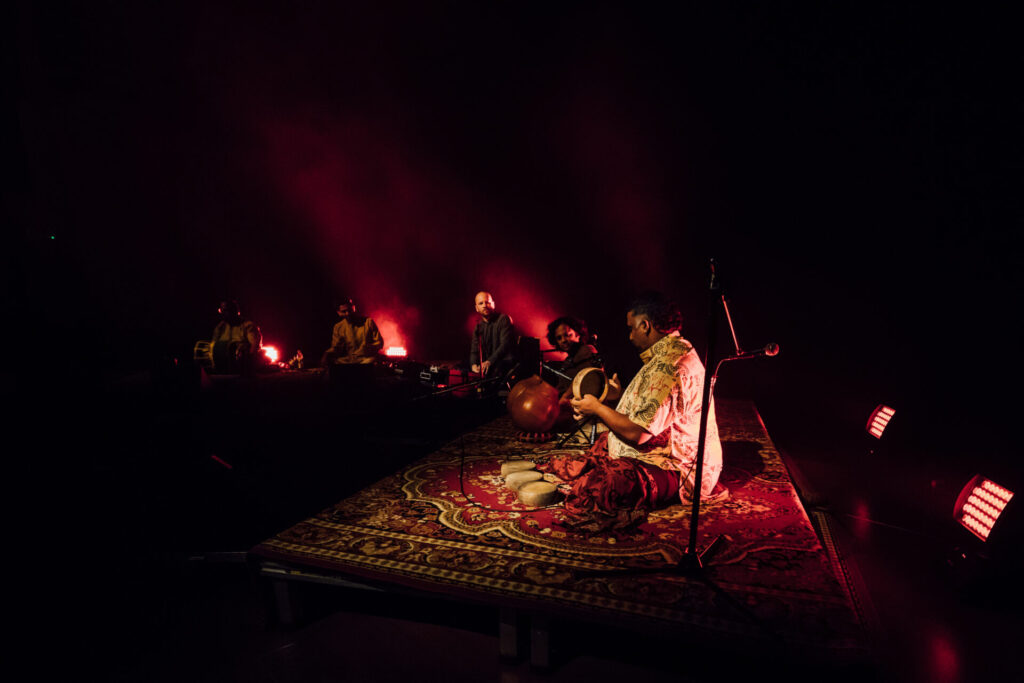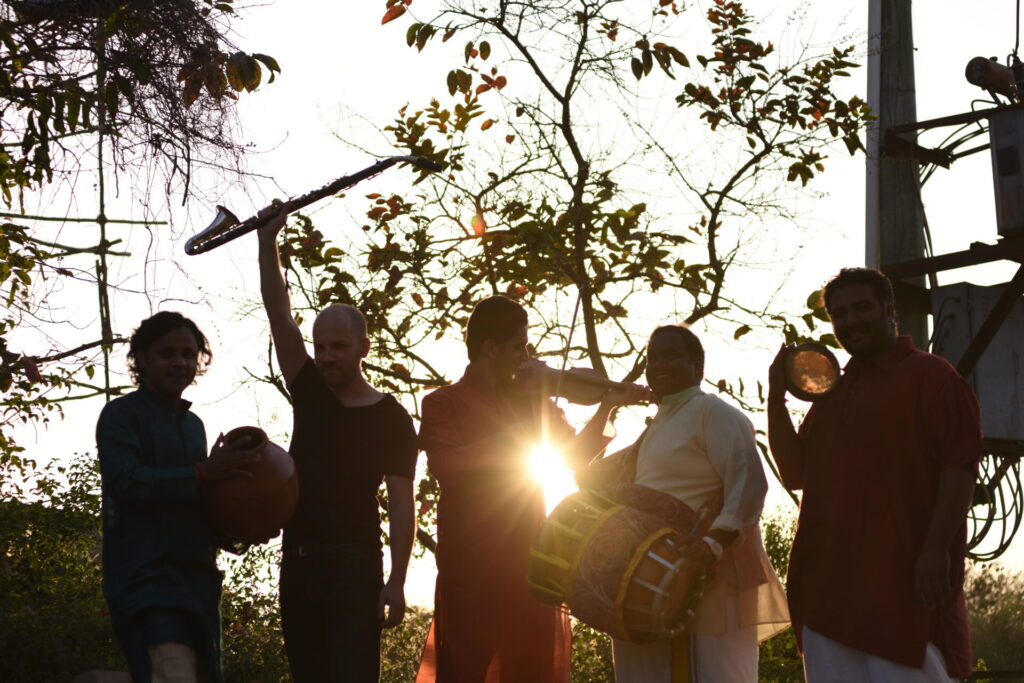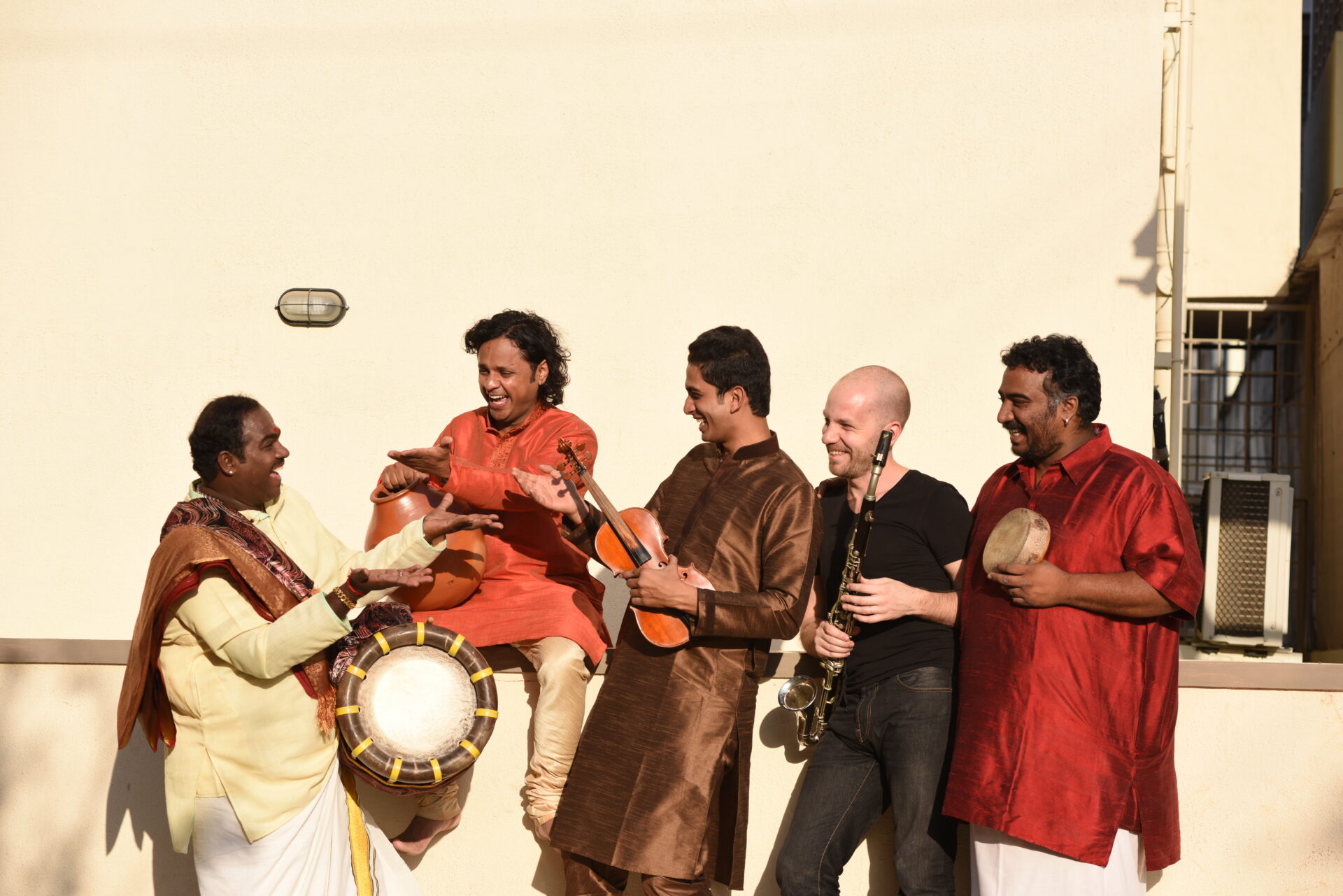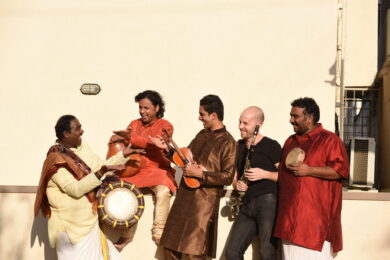In the first few seconds of ‘God Of Bangalore’, the track that opens Saagara’s latest album 3, eccentric rhythms fuse with bulging basslines and sequenced percussion. Synth pads are stalked by a serpentine violin as the steady thud of the ghatam builds up anticipation. Before the first minute has elapsed, we’re thrown into a world that combines musical languages from across the globe.
“It might have been 2016,” remembers Wacław Zimpel, the Polish multi-instrumentalist who, along with the master ghatam player Giridhar Udupa, is one of the main drivers behind Saagara, as he looks back to the song’s origin. “I was in India, walking around Giridhar’s neighbourhood with my field recorder. There was this amazing procession with drummers and folk musicians. I was recording the intensity of the rhythms and it became the inspiration for the track. The rhythm has changed [since then] – everything has changed – but the original vibe comes from the streets of Bangalore.”
tQ speaks with Zimpel and Udupa via video call, each of us dialling in from different parts of the world. We discuss their parallel journeys through music and the roads that led them to develop a style that Zimpel has christened “interstellar folk”. Both musicians are classically trained and began playing at a young age. Udupa was first taught the mridangam – a double headed drum that typically leads in Carnatic ensembles – by his father Ullur Nagendra Udupa, before switching to the ghatam, a tuned earthenware pot. “When I was 9 years old, my father organised a concert and asked me to be part of it,” Udupa the younger says. ”Since there was already a mridangam player, he said I should play ghatam. They belong to the same family. The language is the same but the technique is different. Since then, when I perform classical music in India, I play only ghatam.”
Zimpel also changed instrument early on, from violin to clarinet, absorbing influences from Western classical, jazz and improvised music. He continues to master new sounds and, in recent years, has been incorporating electronics into his work. Last year’s solo album Train Spotter, for example, used field recordings from Warsaw in combination with an arsenal of synthesisers, keyboards and plugins to construct a pulsating portrait of the Polish capital. Saagara’s story, however, goes all the way back to 2012 when Zimpel and Udupa performed together for the first time. “I was very lucky that Giridhar was in Poland that summer,” Zimpel explains. “Our mutual friend Jacek Mazurkiewicz invited us to collaborate – that’s how we met. Before that, I had a big interest in Indian music. Mostly Hindustani music, which is from north India.”

Zimpel was listening to a lot of Ravi Shankar, Ali Akbar Khan and Bismillah Khan along with minimalists like Terry Riley and La Monte Young who studied with Pandit Pran Nath. A desire to understand their compositional approach led Zimpel to Bangalore. “Giridhar introduced me to the flute maestro Ravichandra Kulur who has experience in both Carnatic and Hindustani music. Because I was in south India, and because Ravichandra is mostly a Carnatic musician, he taught me the fundamentals of Carnatic music.” Initially, Zimpel found it difficult to integrate his playing with Carnatic rhythms because he couldn’t follow what the other musicians were doing. However, studying konnakol (a vocal technique through which complex patterns are mapped out using percussive syllables) allowed him to better understand these rhythm cycles, freely improvise within that system, and thereby engage in a dialogue with the other musicians.
Saagara’s eponymous debut, released in 2015, was partially inspired by John McLaughlin’s acoustic fusion group Shakti. “It was a very important band for me, Giridhar and the other guys from Saagara,” Zimpel admits. “They’re legendary and a huge inspiration for us to make a real connection between West and East. Not just being on stage together, but really discovering our own language. My goal was to improvise with Giridhar, Aggu Baba [who plays khanjira], K Raja [thavil] and Mysore N. Karthik [violin] – who joined the band later – on a high level of understanding.” Even though it isn’t unusual to hear synths replacing tambura drones in Carnatic music, there were no electronics employed at that stage. “I told Wacław that it’s nice to have some pads, just a couple,” says Udupa. “And he was so particular: ‘No, let’s make everything acoustic’. So he brought two shruti boxes – manual things. We did two tours like this. From that to Saagara 3 is a drastic change. A complete evolution.”
The band’s 2017 album 2 articulates this careful transformation from an ensemble examining the roots of Carnatic music to one that embraces the studio as a separate instrument. “I wanted us to be as original as possible,” Zimpel says. “But when I started working more in the studio, I started feeling that I needed more control. We used to work with the producer Mooryc and he brought a lot of electronic sounds to our second album. Shortly after, I met James Holden and Sam Shackleton, and playing with those guys was like university for me.” The first song to be recorded for 3 predates the pandemic. ‘The Rite Of Rain’ maps out a new direction with looping synth and organ notes, backed by incisive rhythms, interlocking with Karthik’s violin. Holden mixed the track but also showed Zimpel how to connect the natural timing of Indian drums with sequencers using the Humanizer plugin. “It’s the heart of this whole production,” Zimpel says. “It allows you to translate the natural timing of the drummer to the sequencer, and those sequences start sounding more organic”. Zimpel produced the track in 2018, but it took him several years, and many albums in between, to master the skills required to complete the album.

This journey resulted in a record that has as much in common with its Carnatic roots as it does with a basement jazz club, or indeed a sweat lodge dancefloor. ‘Sunbeam Spirits’ is a delightful track that bridges these spaces. Strings are chopped into a flickering stereo attack before the ghatam breakdown leads you into a joyous clarinet solo that commands attention like a street corner preacher. Considering how Indian classical performances can stretch to three hours in duration, as well as psychedelic heights that their own work can reach, I ask if framing Saagara as trance music is valid. “The spiritual aspect of Indian music was something which brought me into it,” Zimpel says. “It’s about emptying your mind and experiencing the sound, rhythm, raga and harmony going through your body and being open to processes beyond your intellectual capacity.” The best part is that it’s enjoyable, Udupa hastens to add. “Starting from the first note, when we look at each other, we have fun. That’s what connects us to the audience.”
Saagara will be touring Europe in November in support of the new album. Meanwhile, their music has also been received well in India, not only because the group is disciplined and honest about how they experiment with traditional forms, but also because of the energy they bring to the stage. Zimpel concludes: “It is amazing how musicians in India are very particular about the energy in the room, what kind of thoughts or conversation we have in the tour bus, what kind of attitude we have towards one another. We try to bring the best from ourselves. It’s much less the theory about sequencers, Carnatic rhythms and ragas. What’s most important is when we’re all experiencing something extraordinary, something bigger than us. That is what Saagara is about – bringing this energy and spreading it to the world. That’s our mission.”
Saagara’s 3 is released by Tak:til on 18 October.




